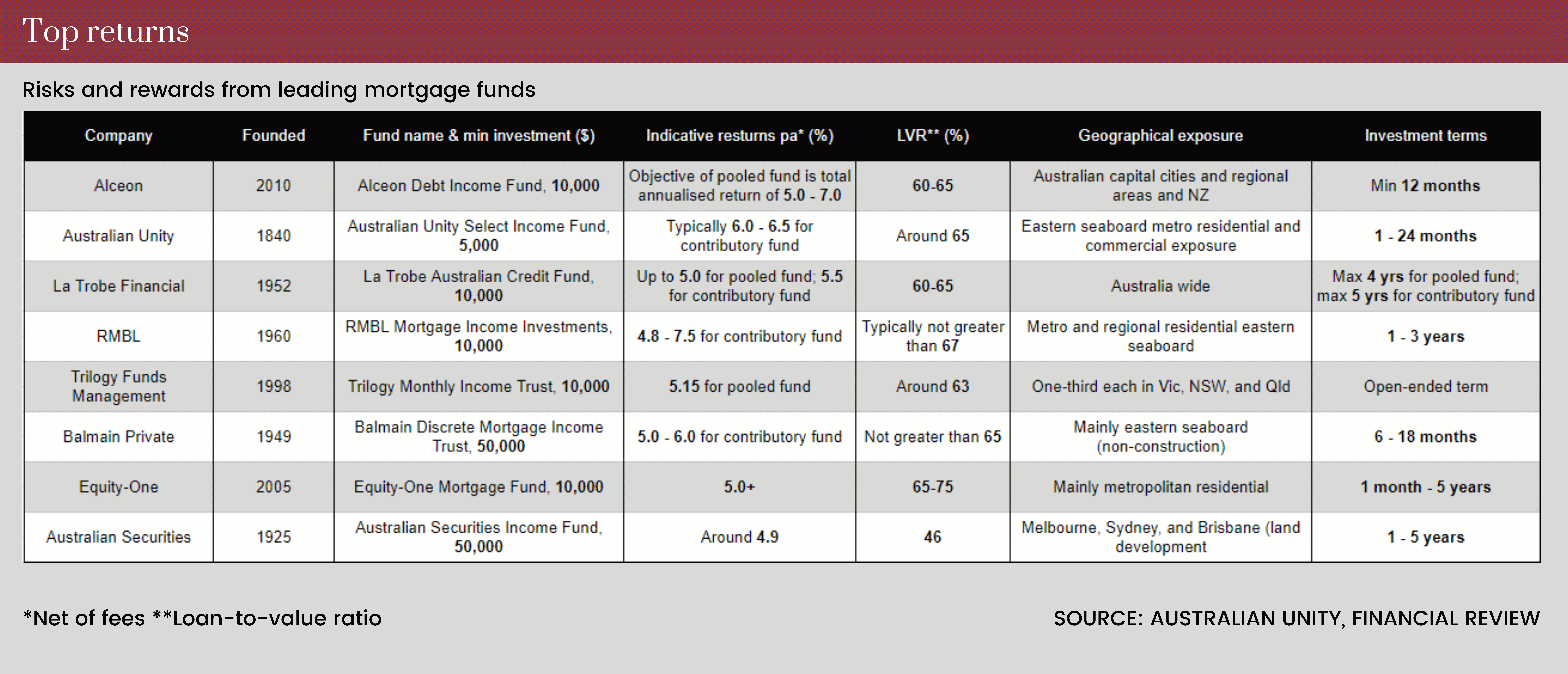AFR’s Top 10 rules in choosing the best mortgage fund.
- 16 February 2022
Duncan Hughes outlines 10 issues to consider for investors seeking regular returns of 4 per cent to 7.5 per cent without putting their savings in danger.
Income-seeking investors fed up with dismal bank rates might consider mortgage funds offering between 4 and 7.5 per cent that are used to fund residential, commercial and industrial property developments.
Financial advisers and product providers say there is a growing demand for such products from investors seeking regular income payments from a sector that continues to generate high growth.
But Nat Daley, a partner at Hardline Wealth, which advises high net worth investors, warns that higher returns come with increased risks, particularly as swings in the sharemarket and the likelihood of rising rates increase volatility.
Mortgage-backed funds imploded during the 2008-09 global financial crisis and many investors trying to pull their money out were either forced to liquidate at a huge discount or prevented from withdrawals.
Tough lessons were learnt by fund managers – some of whom disappeared from the sector – and regulators, who introduced tougher monitoring to better protect investors from losing their savings.
The cause of renewed investor interest is the search for an alternative to low savings and fixed rates from banks, particularly among retirees seeking reliable payments that provide a higher return than inflation.
The annual return on a $100,000 average term deposit account is $520 (or 0.5 per cent). The return on the same amount in the average savings account offering 0.3 per cent, excluding bonus and no extra payments, is about $300, according to an analysis by Canstar, which monitors rates. ‘‘Investors considering mortgage funds need to look under the hood and understand what powers the returns,’’ says Daley.
The accompanying table provides a range of mortgage funds from established providers offering returns from about 5 to 7.5 per cent, with investment terms ranging from one month to five years.

Investors considering property mortgages can choose between contributory mortgages and pooled mortgage funds offering anything from conservative residential projects to highly speculative commercial and industrial developments.
Contributory funds enable investors to buy an interest in the mortgages of a developer building anything from townhouses and apartments to small commercial buildings. These are handled by fund managers who allocate the funding to projects traditional lenders may find too risky. As such, they are paid higher rates by developers.
Some fund managers provide project lists that an investor can match to their appetite for return and risk.
Alternatively, investors can choose a pooled mortgage fund where the underlying properties, which can include a mix of residential, commercial and industrial, are managed by a fund manager.
According to the Australian Securities and Investments Commission, investors should speak to their financial adviser, read the product disclosure statement and seek clarification from scheme managers on any outstanding questions.
Key benchmarks that should be considered by an investor include:
1. The track record of the team offering the product. Roy Prasad, general manager of mortgages at Australian Unity, says experience managing projects, particularly during current times when there are serious supply issues, requires experience and understanding of the market. ‘‘There are lots of new managers who promise a lot,’’ says Prasad. ‘‘But many do not have the experience of successfully managing a fund through the peaks and troughs of an economic cycle.’’
2. Scheme borrowings. Investors need to be confident the scheme is not too highly geared. Seek an explanation if a loan-to-value ratio is higher than 75 per cent. How much money does the scheme owe and when are the debts to be repaid? How much can the scheme borrow compared to how much it has already borrowed?
3. Liquidity. ‘‘This is an important consideration,’’ says Hardline’s Daley. ‘‘Investors need to know how long their money is invested for and the costs of early withdrawal,’’ he says. Does the fund have the cash available to return money at short notice?
4. Valuation. Is there an independent valuation panel? Are the lawyers and quantity surveyors independent? ‘‘Investors have to ensure there is an arms’ length assessment of the projects,’’ says Prasad. ‘‘They need to ensure that that offering advice are independent.’’ Check whether there are procedures to deal with any conflicts of interest.
5. Related party transactions. Make sure advisers claiming to independently recommend funds are not receiving kickbacks, or commission, from the project managers.
6. Level of return. Australian Unity’s Prasad warns many investors are attracted by funds offering double-digit returns without asking how the rates are achieved. ‘‘If it looks too good to be true, it probably is,’’ he says. ‘‘The market will deliver certain levels of return. Excessively high returns could be a warning about higher risks.’’
7. Rising interest rates. Spikes in yield may be attractive for investors in the short term but may put borrowers under pressure.
8. Withdrawals and return of capital. Most contributory mortgage schemes only allow withdrawals when the mortgage invested in matures. Pooled mortgage schemes allow withdrawals at short notice. But in most cases, it might take up to 12 months to get your money back, according to ASIC.
9. Diversification. A heavily concentrated portfolio in a few loans, or loans to a handful of borrowers, increases risk. Are the projects different sizes with different borrowers and based in different geographic regions? ASIC recommends no asset is worth more than 5 per cent of the total fund and no borrower is loaned more than 5 per cent of the fund’s mortgages. Daley recommends investors review average loan sizes, loan-to-value ratios, loan terms and portfolio diversification to ensure risk is diversified.
10. Advisers recommend that mortgage funds should not comprise more than 10 per cent of an investor’s portfolio.
View original article
If you would like to discuss your investment options with Equity-One, contact us now.
